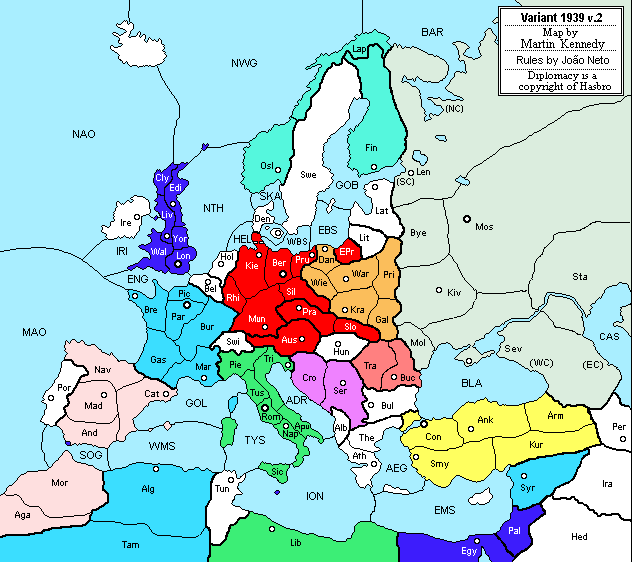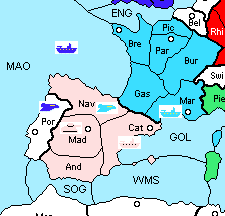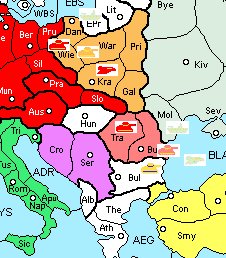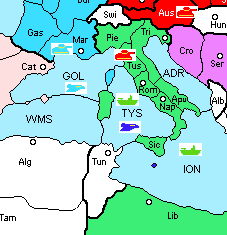Diplomacy Pouch | World Masters 99
Gerson Sunye's Ąs Armas |
Carlos Brito's Dip webpage | Joćo
Neto's webPage
1939
Diplomacy on the verge of World War II
by Joćo Pedro Neto
Introduction. I'm a Diplomacy fan (as you might have guessed). I'm
also a curious reader of the most important war in this century, the 2nd
World War. And, last but not least, I love games and changing their rules. Taking these
three features of myself, I decide to give it a try and make a new Dip variant starting on
August 1939. Germany is about to strike Poland, and Great Britain and France are wondering
if they go to war together to stop Hitler's never ending ambition. Well, you all know
that!
The main features of this variant are air units for land/sea support; satellite powers
managed by the main powers and some little extra rules for historical resemblance. You can
get the map, this html and all unit gifs in here [~70k].
Before I started this variant, I was looking the existing Dip variants, and found Versailles. I borrow the map
and made some changes. Also, the satellite powers in 1939 were inspired by a similar
concept in Versailles, but there, each power is controlled by just one player. Not quite
in 1939...
 There is a first version of the rules with a game in
progress. This page presents the second (corrected and enlarged) version rules set
for 1939. In this version, it was included optional rule modules introducing cunning
U-boats, secret Spies and (almost) unbreakable Alliances. Hope you like it... and play it!
There is a first version of the rules with a game in
progress. This page presents the second (corrected and enlarged) version rules set
for 1939. In this version, it was included optional rule modules introducing cunning
U-boats, secret Spies and (almost) unbreakable Alliances. Hope you like it... and play it!

Rules

- The Rules of Diplomacy™ applies except on the following:
- To better emulate the dynamics of W.W.II, in each year there are 4 move turns with 2
build turns (i.e., Spring Move, Summer Move, Summer Build, Autumn Move, Winter Move,
Winter Build). The game starts at Autumn 1939.
- There are the following main powers: Germany, Soviet
Union, Britain, France, Italy and Turkey.
-
There are the following satellite powers: Poland, Finland,
Spain, Yoguslavia and Rumania.
- Two units of the same power may swap their positions (while using legal
Dip moves).
- Air units:
- Each capital (Berlin, Moscow, London, Paris, Rome and Istanbul) has one air unit, called
a plane.

- If a power has N capitals, it has N planes. When a power takes a capital, the specific
plane - in the next build turn - changes owner and restarts at the power's capital (if the
capital is occupied by other plane, the build must wait until next year).
- Line of Action (LoA):
- Planes have limited LoA. An air unit of a power must be in a province that is in contact
with a original province, a center or a unit of that power (even if an unit only gets in
contact as a result of that move).
- If the plane is supported by a unit that moves or retreats, the plane may became
out of its LoA, and in that case it must move. If there is no possible move, the plane is
destroyed and restarts on the player's capital in the next construction turn.
- If there is already another plane in the capital, the player can choose another of his
original centers. If no center is available, the plane must wait until one of those
centers gets available (i.e., with no planes).
- An original province gives always LoA to its own plane, even if that province is
conquered by another power.
- Movement:
- Planes orders are consisted of two parts: move and support.
- The move part tells where the plane goes: (a) hold its position, or (b) move to an
adjacent space inside its LoA.
- The support part tells what it does there: (a) hold the position, (b) bomb the land/sea
unit, or (c) support an order (an hold, a move or a convoy).
- Therefore, there are the six following possibilities:
- P A Hold Hold, the plane at A does nothing;
- P A Hold Bomb, the plane bombs the land/sea unit at A;
- P A Hold S order, the plane at A does not move and support a legal order;
- P A - B Hold, the plane just goes from A to B;
- P A - B Bomb, the plane goes from A to B, and bombs the land/sea unit;
- P A - B S order, the plane goes from A to B and support a legal order;
- Some extra notes:
- Armies and fleets cannot support any plane orders.
- The plane move part may be supported by other plane(s). So, it is possible that a plane
should retreat due to a supported plane movement into its space (check special case of
Malta below).
- In case of a retreat, the move and the support part are cut.
- In case of a bounce, the support part is cut.
- The plane support part cannot be supported by any unit.
- Bombing a air/sea unit cuts any support made by that unit.
- Bombing a fleet disrupts an unsupported convoy made by that fleet.
- A plane cannot claim a province, only armies and fleets.
- Planes may not cross Switzerland.
- Satellite Powers:
- Each satellite power is controlled by one or several main powers.
- Each unit can only move/support/convoy, if the controlling powers send the same move,
otherwise it holds its position.
- Each unit can only retreat, if the controlling powers send the same move, otherwise it
is destroyed.
- The build order must coincide, or else there is no build.
- The remove order must coincide, or else the Master removes the necessary units using a
random method.
- If a power P controls a satellite and is eliminated, the satellite is controlled at each
turn by those nations holding the original centers of P in that turn.
- Satellite List:
- Poland is controlled by Britain and France.
- Finland is controlled by Germany and Britain.
- Rumania is controlled by Germany.
- Spain is controlled by Italy and Germany.
- Yugoslavia is controlled by Soviet Union and Turkey.
Special Cases:
- Silesia: Due to the Blitzkrieg surprise attack against Poland, Germany
may put its Berlin army in Silesia just before the game starts.
- Danzig: A German unit entering Danzig is always supported by East
Prussian Germans (EPr), i.e., they have force 2 when entering Danzig province.
- Warsaw: When Germany conquers Warsaw, it gains another plane at Berlin
(if there is already a plane in Berlin, the building must wait until the next building
phase). This plane is definitive, even if Germany looses Warsaw.
- Russian Winter: All Soviet forces have force 2 in the winter when
holding or moving into Soviet provinces.
- Caspian Sea: There is a connection between Sevastopol (west coast) and
Stalingrad that can be crossed by sea units.
- Sicily: The Italian island is connected to Naples by land.
- Malta: Britain has an extra plane in Malta that cannot be conquered
(except if Britain is killed, then it disappears). This plane can only fly between ION,
TYS and Sicily. It stays at Malta while there is no moving options or retreats due to a
plane attack. The plane starts at ION.
- Gibraltar:
British planes have an implicit LoA in SOG, Mor and
And due to Gibraltar. As in Malta, a British plane may stay at Gibraltar
while there is no moving options or retreats due to a plane attack.
Africa Korps: Between Spring 1941 and Winter 1942, Germany can deploy
one army (placed in a German original province) to Libya per turn. This is treated as a
regular move (i.e., it can bounce or be supported).
United States of America:
- Americans enter the game at Autumn 1942.
- The command of these units are made by France and Britain (as if they were a satellite).
- All American units are build and transferred from the virtual province USA.
- American builds only occur during Winter season.
- Initially, the American units consist of 1 plane and 2 units (Fleets or Armies).
- Britain and France must choose what type of units they will build (B F USA or B A USA)
and where to deploy them (armies may move "A USA-Agadir" or "A
USA-Palestine", fleets may move "F USA-MAO" or "F USA-NAO", and
planes within the LoA of American units).
- All moves "USA - province" cannot be stopped, so if there are any
non-American units there, they must retreat.
- Planes may move within the LoA of American, British and French units.
- Centers conquered by American forces only create American units (these centers do not
count has British or French centers!). For N American centers, there can be N+2 units (the
two extra units are the initial ones)
Air Jets: Between Fall of 1944 and Fall 1946 (5 seasons),
one German plane
have double strength (the jet invention). After that, it will return to normal, since his
enemies also learn how to build jets.
Initial Placements:
- Germany - Army: Mun, Aus, Pra, Pru, Ber (or Sil); Fleet:
Kie; Plane: Ber.
- Soviet Union - Army: Kiv, Mos; Fleet: Len(sc), Sev; Plane:
Mos.
- Britain - Army: Liv; Fleet: Lon, Edi, Egy; Plane:
Lon, ION.
- Italy - Army: Tri, Lib; Fleet: Rom, Nap; Plane:
Rom.
- France - Army: Par, Mar; Fleet: Bre, Syr, WMS; Plane:
Par.
- Turkey - Army: Ank; Fleet: Con, Smy; Plane:
Con.
- Poland - Army: War, Kra; Fleet: Dan;
Plane: War.
- Spain - Army: Mad; Fleet: Cat.
- Finland - Army: Fin, Osl.
- Rumania - Army: Buc.
- Yugoslavia - Army: Ser.
Wins who conquer 50%+1 centers, i.e., 25 centers to achieve victory (there are 48
centers in the map).
There will be presented optional module rules. These modules can be added to create
more or less complex diplomacy games. This is an advantage to the players, since they can
control how complex a 1939 game can be.
OPTIONAL MODULE - U-BOATS 
- An U-Boat is a special unit just like a plane, except for:
- They can only move in seas.
- Special cases: U-boats may cross directly through: AEG and BLA, BLA and
CAS, WBS and SKA, WBS and HEL.
They do not have LoA and may not be used to define plane's LoA.
Instead of bombing, U-Boats can mine seas. A Fleet within a mined sea, cannot support or
convoy any unit.
An U-Boat can also Torpedo a sea. A Fleet or U-Boat entering such sea faces a force 1
defense. This order can be supported by other U-Boats and Fleets (they must be adjacent to
the specified sea)
U-Boats have an extra move order: "Follow". This order binds the U-Boat to the
current Fleet that is placed on that sea. That way, where the Fleet goes, the U-Boat also
goes (except if it bounces in another U-Boat or the Fleet goes to a coastal province).
E.g., "U NAO Follow Mine" says to follow the NAO Fleet and if the Fleet does not
move, to mine the sea (i.e., it cancels all convoys and supports).
Any power can build U-Boats instead of Fleets.
Starting in Autumn 1943, a plane can cut an U-Boat order (mining and others) by bombing
that sea.
Germany starts with an U-Boat at HEL. If Germany looses Kiel, it cannot use it until Kie is German
again.
OPTIONAL MODULE - SPIES 
- A Spy is a special unit with the following features:
- One spy per power.
- Secret moves - no one knows where a spy is.
- Spies do not have LoA.
- Spies do not bounce each other or with any other piece.
- Spies may enter Switzerland! (anathema!!!).
- A Fleet can convoy a spy, just by holding its position (secret convoy). Notice that even
an enemy Fleet holding its position may be used to convoy any spy.
- Each spy has an Home. By default it is the Power's Capital. If the player looses its
Capital, he must inform the Game Master of its new Home (any original province, with or
without supply center) .
- In each turn, a spy can move and then issue an order (just like planes).
- The set of possible orders are:
- Reveal - returns all spies on that province and in the adjacent ones (except for
Switzerland) and if there are any attachments to himself (see next point). It also reveals
and deactivates any Sabotage (see below) in process by one of those spies.
- Track Spy power - if a Spy is revealed in the previous turn, this order
"attach" the spy to the tracked one. Where the tracked spy moves, the tracking
spy also moves there. All orders issued by a tracked spy are void. When the tracking spy
orders something different, the attachment is broken.
- Return Home - the spy returns to his Home, and all attachments are broken.
- Sabotage - prevents any building on that province. Must be ordered in the last two move
turns before the building turn.
- Block - prevents the move of any regular unit (i.e., Army or Fleet) with strength one
placed on the spy's province or cuts any support made by it. His current position is
revealed. Blocking does not accumulate with other units orders.
- Command order - if the Fleet or Army placed in the same province orders an Hold
or the order was Void, then that unit executes order. If two different command
orders from two spies occur, the unit still holds.
- [Alliance module on] Reveal Alliance - must be ordered in the other player's
Capital. Returns all power's alliances.
OPTIONAL MODULE - ALLIANCES
- Any two powers (main powers or satellites) can ally.
- An alliance is a secret to the other players.
- To create an alliance, each power must send a <alliance other-power>
order. Some notes:
- Only one alliance order per turn per power.
- To ally with satellites, each controlling main power must send the same alliance order.
- To break an alliance, a power must send a <dissension allied-power>.
However, the alliance is only void in the next move turn.
- Only one dissension order per turn per power.
- A satellite can only break an alliance, if all controlling powers send the same
dissension order.
- Two allies can:
- Share their units LoA.
- Swap units.
- Two allies cannot:
- Attack allied units.
- Cut each other supports or convoys.
- Control each other supply centers (a unit pass through an allied center, but do not
conquer it).
- [Spy module on] Spy treason: If a power has a Spy in the allied Capital, he may
betray his ally (nothing is for sure in Diplomacy). The Spy returns Home. However, the
alliance is not broken.
I want to give special thanks to Cristiano Corte Restitutti who gave the
initial idea for Spies and U-boats, and is working with me to improve all these modules.
Also, I wish to thank André Leme-Lopes and all the other players of Game01.
Happy stabbing!

Map



Examples


|
Planes
in action:
- The French plane can support into the following spaces: Gas, Cat and MAO (all France
neighbor spaces).
- The British plane (attached to the MAO fleet) can support into Nav, Por and MAO. However
he cannot go to Nav since the French plane is there; or to Madrid, since Portugal is not
British and the MAO unit cannot go there.
- If the MAO fleet moves/retreats to Eng, the British plane must retreat to MAO (but only
in the retreat phase, it does not interfere with the plane orders for that turn!).
- In case of: F Mar - Cat; P Nav Hold S F Mar - Cat; F Cat Hold; A Mad
S Cat, then there is a 2:2 bounce between them.
- If P Por - Nav Bomb (or P Por - Nav HOLD), the French plane support is cut
and there is a bounce between the 2 planes.
- If the British plane could go to Madrid (e.g., Portugal is dominated by Britain), then P
Por - Mad Bomb would cut the Army support and the French fleet would enter Cat.
- In the last case, if the move is P Por - Mad Hold then the Madrid support would
not be cut.
|

|
Satellites:
- If A Wie - Dan; F Epr - Dan; A War S A Epr - Dan; P Kra - War Bomb,
then German army enters in Danzig, since the plane cuts the support, and Germany has
automatic support from East Prussia.
- If A Tra S Buc; F Buc Hold; F Mol - Buc; P BLA Hold S Mol - Buc,
then the unit in Bucarest holds. Germany may use the Rumanian army.
- If also A Bul S Mol - Buc; then the Rumanian army is destroyed and cannot be
rebuild (since there are no Rumanian centers left).
|

|
At
Fall 1941:
- Let's take the following moves: A Aus - Lib (Africa Korps special case), A Tus
- TYS - Tun, F TYS C A Tus - Tun, F ION S C A Tus - Tun, P TYS Hold
Bomb. In this case, there will be 2 German units in North Africa. The British plane
wasn't able to cut the convoy, because of the ION support.
- The French plane at GOL cannot attack TYS, since it is not in its LoA (the plane can
only go to Cat, Mar, or Pie). However, if there were a French ship at GOL, the convoy
could be cut by sending: P TYS - ION Bomb, F GOL - TYS, P Hold S F GOL -
TYS.
|
Last modified by Joćo Pedro Neto at 07/06/02

This Diplomacy Ring site is owned by Joćo Neto.
Want to join the Diplomacy Ring?
[Skip
Prev][Prev][Next][Skip
Next][Random][Next
5][List
Sites]
![]() There is a first version of the rules with a game in
progress. This page presents the second (corrected and enlarged) version rules set
for 1939. In this version, it was included optional rule modules introducing cunning
U-boats, secret Spies and (almost) unbreakable Alliances. Hope you like it... and play it!
There is a first version of the rules with a game in
progress. This page presents the second (corrected and enlarged) version rules set
for 1939. In this version, it was included optional rule modules introducing cunning
U-boats, secret Spies and (almost) unbreakable Alliances. Hope you like it... and play it!






